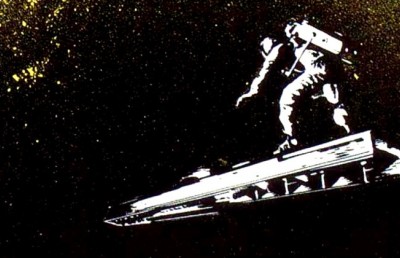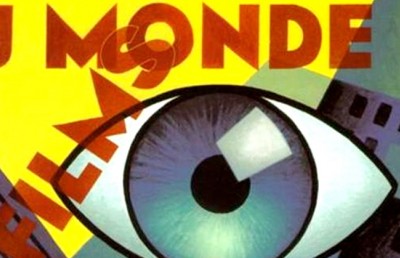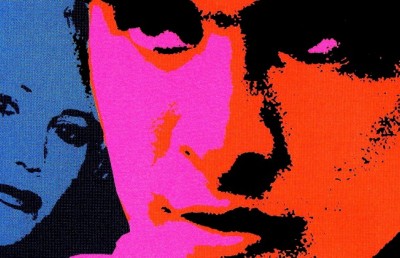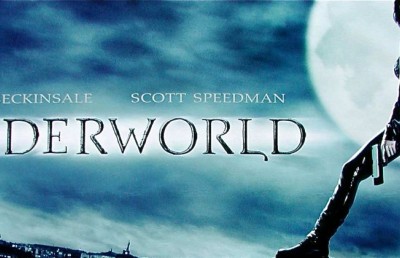Death Bed: A Lost Cult Classic
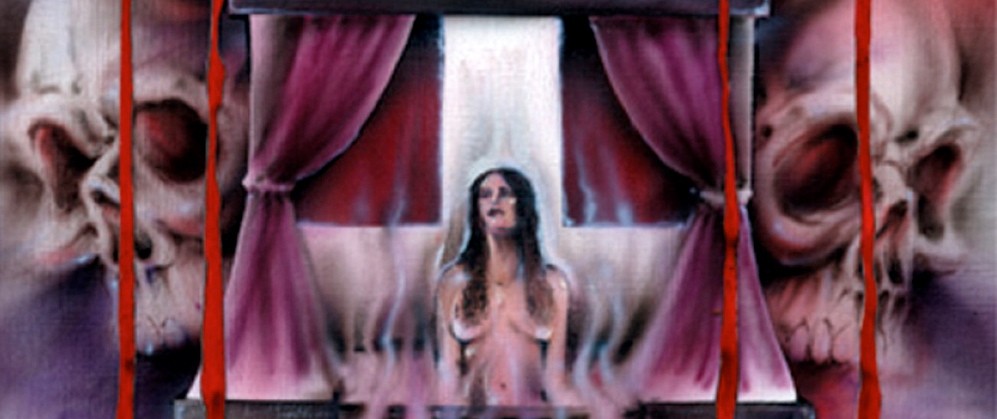
If you think the bumping and grinding bed from The Exorcist was weird, well you obviously have not seen Death Bed: The Bed that Eats. This is one of those weirdly titled films (echoing Peter Weir’s The Cars that Eat People 1974), which actually lives up to its odd title. This is a genuinely rare American attempt at blending off-the-wall surrealism with horror: a bed possessed by a demonic spirit which eats people. Shot on 16mm, Death Bed was five years in the making (1972-1977), and languishing in the bowels of cult film limbo until a series of coincidences brought this oddity above ground. (For a good account of the film’s unusual production history read Stephen Thrower’s overview at Amazon.com – which is an extract from his upcoming book Nightmare, USA – or his liner notes on the Cult Epics DVD).
Apparently it all started around a bootleg video copy that circulated in the UK during the video nasty period (early 1980s), which translated to a fanzine buzz which has led to the film being picked up for a DVD release and small theatrical run by Cult Epics films. The film’s stunted production history is also recounted by director George Barry in his 6-minute introduction on the DVD. I was fortunate enough to see the film at a late night screening at Montreal’s Repertory Theatre Cinema du Parc, but the excellent Cult Epics transfer of the film includes additional recently added sound not present on the theatrical print I saw, namely a minimalist ambient electronic score by the group Cyclobe (composed of Stephen Thrower and Ossian Brown).
The Bed that Eats begins with a rather daring Dadaist prank: 60 seconds of a black screen with only crunching sounds, which ends with the intertitle: “Breakfast.” This leads to an introduction of the film’s central location, a spartan, cavernous room housing a large baroque bed, a fireplace, and a drawing of the bed hanging on a wall. Some of the film’s best stylistic moments come in this beginning, where the camera slowly explores the surroundings of the room, tracking past the imposing bed to its picture on the wall. We are then introduced to the film’s ostensible on/off-screen narrator: a young ‘undead’ painter (played by Dave Marsh), modeled after the Victorian illustrator Aubrey Beardsley, who, dying of consumption, decided to paint a sketch of his ‘death bed’ in 1917. For reasons unknown to the artist, the murderous bed decided to spare his life, and instead imprisoned him behind the painting, forcing him to observe the bed’s untidy —excuse the pun— bedside manners. As his (slightly British-accented) opening voice-over tells us, “I’ve been imprisoned behind my painting in this limbo for 60 years now since my death.” The artist-narrator also has the uncanny ability to communicate with the bed and knows exactly what it is thinking and feeling.
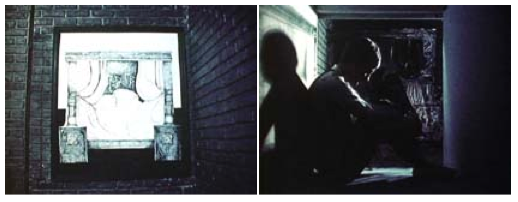
The origin of the vengeful spirit in the bed goes back to a story recounted to us by the film’s artist/narrator trapped behind his own art (an apt metaphor for the artist’s undying devotion to his/her art). In the story a demon taking refuge in a tree changes itself into an oncoming breeze. In its ethereal ‘wind’ state the demon falls in love with a beautiful woman dressed in a long black gown standing forlornly by a swamp (Linda Bond). The demon then takes human form and creates a bed in order to seduce the woman. The demon in its human form is seen in striking close-ups with Christopher Lee-like blood red eyes. As a result of their unholy alliance the woman dies during their lovemaking. The grieving demon’s blood-red eyes crack, causing droplets of blood to spill onto the bed. The demon escapes once more to take refuge within a barren tree, but the dried blood takes root in the bed and transforms into a demonic spirit ‘trapped’ in the bed (echoing the artist trapped in his artwork).
After the 60 second black screen, the pre-credit scene continues with the first set of victims, a young couple (‘breakfast’) looking for a place to make love who break into the grounds of a once grand estate and settle into the room housing the bed (the estate’s remaining edifice may have been the servant’s quarters). Once the couple begins to make love they are literally sucked into the bed by yellow soap-like suds that surface to the top of the bed and pull the victims (human and otherwise) into the bowels of the bed. Director Barry cuts to ‘side’ views of the bed, picturesque, painterly shots of the objects being submerged in fanciful colored water (yellow, orange, and red). (The title should read Death ‘Water’ Bed actually.) And this particular bed has an appetite for everything, including the conventional (fried chicken and wine) and the unconventional (corkscrews, books, and suitcases!).
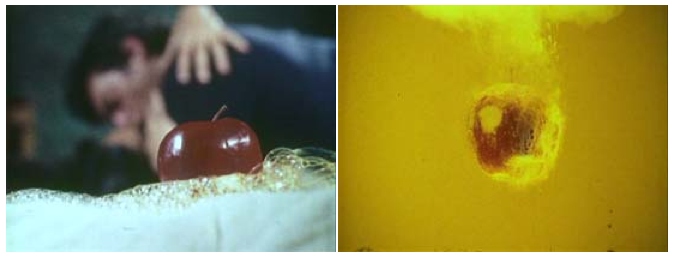
After the credits the next intertitle reads, “Lunch” and is followed by the introduction of the next set of victims, three young women, Diane (Demene Hall), Suzan (Julie Ritter), and Sharon (credited as Rosa Luxemburg, but that must be a pseudonym), who visit the house because of a common friend who was placed in charge of liquidating the estate. Two of the women, Suzan (“Lunch”) and Diane (“Dinner”), succumb to the bed’s insatiable hunger, as victims have been doing for sixty years. Sharon, in shock after witnessing Diane’s gruesome death, is found lying comatose on the room’s floor by her brother (Rusty Russ). Diane’s eyeball emerges from the bowels of the bed to roll around the bed, disappear, and then re-emerge, taunting Sharon and her brother. Somehow the brother is able to deduce exactly what is going on from the prancing eyeball (Sharon has not spoken a word to him), and attempts to pull Diane out from the bed. His arms get sucked into the bed, but he manages to pull them out, revealing hands that are completely stripped of flesh. His calm reaction as he stares at his skeletal hands is one of the film’s zaniest surreal touches.
From the first time the three women entered the room the artist-narrator, who has the ability to know what the bed is thinking and feeling, noticed something unusual in the bed’s behavior: a sense of deference, fear, and physical pain (we see the bed ‘bleeding’ inside) whenever in Sharon’s presence. Unlike everyone else who has come into the room – with the exception of the artist – the bed has resisted the temptation to kill her. After searching for an answer by recalling the bed’s many victims (a montage sequence played mainly for laughs), the artist deduces that the bed’s behavior toward Sharon is a result of the uncanny resemblance between her and the woman who the demon fell in love with (the lady in the black gown from the flashback). We also learn that once every ten years the bed must sleep (another surreal idea….a bed that ‘sleeps’) and during this time the artist is momentarily able to communicate beyond the painting to people in the room. In the film’s conclusion the artist deceives Sharon into committing a ritual where she is sacrificed in exchange for the resurrection of the demon’s lover, who is then able to burn the bed. In a vaguely happy ending, the destruction of the bed frees the artist’s spirit from its fate of eternal imprisonment.
Apparently the story was based on a dream that director Barry had, although there is also a strong folkloric and fairytale quality to the film. The film’s basic premise reminded me of the 1996 Korean hit The Gingko Bed, which tells the story of a General whose fiancée seals her fate when she falls in love with a musician from the General’s court. The General does not take kindly to the situation and has his fiancée and her lover murdered. One day the souls of the two lovers take form in two newly grown gingko trees. The General destroys one of the trees, while the spirit contained in the other tree, that of his former fiancée’s, is transferred into the titular bed. The back story to Death Bed is similar, only with a less direct folkloric intent.
While an original piece of exploitation art, the film does not always successfully negotiate the shifts in tone, from comic surrealism, to poeticism, to camp, to horror. In some instances the bed’s malevolent deeds cause death and pain. For example, Suzan’s death is a very effective horror set-piece. (While her nightmare of being served a disgusting plate of green gruel with snails and a wasp is the film’s most squeamish moment). Soon after Suzan falls asleep, the bed swallows her cross and begins to vigorously shake the chain back and forth across Suzan’s neck. The scene crosscuts from the cross under water to the necklace rubbing vigorously against her neck. Blood begins to swirl underwater, and seep from between her toes, but there is no blood visible where we would most expect to see it, on her neck.
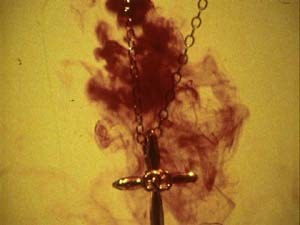
In other instances the effect is humorous, as when Sharon’s brother reacts to his two skeletal twigs at the end of his arms with stony bemusement rather than pain. The film contains several flashbacks of the bed’s previous victims which are mainly played for comic effect (a priest, a matronly lesbian, a couple of clichéd gangsters); as is the montage backdrop of the bed’s history, recounted through a faux March of Time style newsreel and doctored early twentieth century stock footage of New York city (a scene which oddly foreshadows Guy Maddin’s retro-style). On other occasions director Barry goes for outright comedy, like the cut to a Pepto-Bismol bottle floating in the bed’s water/slash stomach after a particular harsh dining experience.
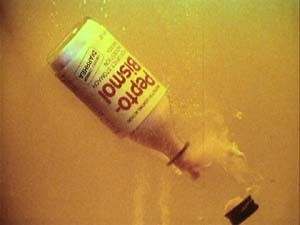
Even when not being overtly funny, Barry finds it hard to play a scene straight or in one register. An example is Diane’s death scene, which is purposely prolonged to frustrate the viewer’s expectation and patience. Diane is swallowed by the bed but manages to pull her torso out of the bed’s death grip. She falls onto the floor, but is unable to use her bloodied, broken legs. Determined to escape, she begins to slowly drag herself along the floor toward the door. With her legs pressed together as one, her slithering body movement makes her look like a snake. To underscore the connection Barry accompanies her slithering movement with a ‘rattling’ sound. Barry records her slow, torturous crawl in a continuous tracking shot of 2’20”, by far the longest take in a film with an otherwise quick cutting rate. She finally arrives at the door and opens it, only to be ‘lassoed’ with a sheet and pulled back by the bed.
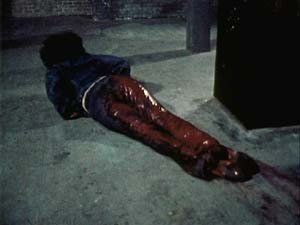
In contrast to these moments of hilarity and horror are several poetic touches, such as the coda to the ‘necklace’ death. Right after Suzan’s death the scene shifts to the exterior grounds of the house, where red roses have magically sprouted from inside Suzan’s skull. Even on 16mm, the bold color composition of the flowers in the extreme foreground with the two other women in the background is quite striking. Another poetic moment comes in Diane’s pre-death dream scene, where she encounters Suzan (dead at this point in the narrative) sitting by the fireplace flipping through a ‘book of the dead’ whose pages are merely silver, reflecting surfaces. After Diane looks through it she brings the book down by her side and we see the burning flames from the fireplace reflected in its pages. Although this lack of tonal consistency may appear to be a weakness, it is in fact what makes Death Bed unclassifiable and gives it its awkward charm.
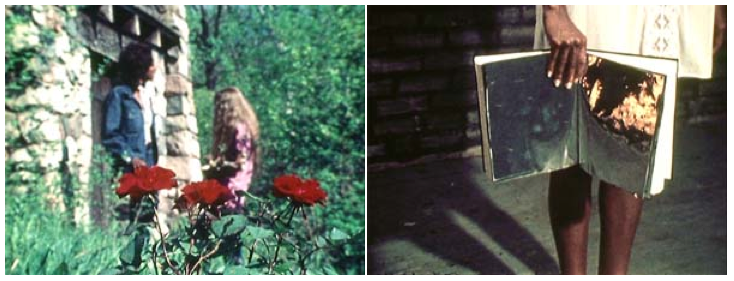
Even films as below ground as this are not created in a vacuum, and therefore Death Bed can be seen within the lineage of the horror genre. The character of Suzan, who looks like a cross between Diane Keaton and Lillian Gish, is the outsider of the three, and confides her insecurities to us in a voice-over flashback as they drive to the estate. The use of voice-over, with the constant references to her “trying to get out,” recalls the Eleanor Lance (Julie Harris) character from The Haunting (1963). In terms of intertextual touches (conscious or not), the image of the young man trapped in the painting, shot from either side of the painting (the looking glass), recalls the antique, haunted mirror from the first segment of Dead of Night. While the tragic ‘man in the painting’ also recalls the ‘man in the radiator’ from Eraserhead. Although the film does recall other horror film imagery and contains some horror film conventions (the evil house off the deserted road, the unsuspecting victims who unwittingly step toward their death, the couple that are murdered as they engage in sex, etc.), it remains as unique and curious a film as you will find. It becomes odder yet when you compare it to other films being made or released at the same time; for example, the film feels a planet removed from Halloween, which came out only one year later (although there is the parallel of the opening murder committed as characters have sex).
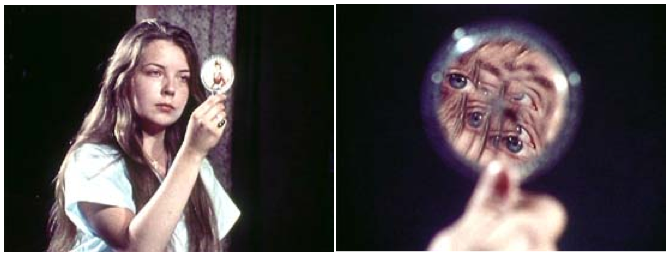
Granted it is hard to do justice to the bizarre spirit of this film, whose parts, in the end, are often better than the whole. And there is no hiding its low-budget (roughly $30,000) shortcomings. The post-dubbed sound is not always convincing; the day for night is never convincing (we hear crickets all the time, so it sounds like night, but it sure don’t look like night); and the plot is sometimes cumbersome. But no one should be looking for perfection in a story which strives for surreal irrationality, and which offers more in the way of symbolic gesturing than narrative coherence (especially as a reflexive piece on the artist as creator and destroyer). In fact, a large part of the film’s charm comes from these rough edges. With its rediscover, Death Bed should earn its rightful place in the annals of 1970s midnight cult cinephilia along such films as Eraserhead, Pink Flamingos, Lemora: A Child’s Tale of the Supernatural, A Boy and His Dog, and El Topo. (For another review of the film I recommend Daniel Craddock’s online posting at the Lightsfade website).



